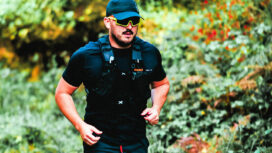The daughter of a SAS hero from Harman’s Cross in Dorset has been invited to attend a moving ceremony in France to mark the 80th anniversary of the worst ever massacre of SAS operatives.
Joanna Weaver’s father, Major Peter Weaver, was one of the few survivors of Operation Bulbasket behind enemy lines in Nazi occupied France in the summer of 1944.

Major Peter Weaver, pictured second from right, with other members of 1st SAS, B Squadron
Tasked with sabotage missions
Their mission was to sabotage German supply lines from Bordeaux to the beaches of Normandy, to hinder their attempts to reverse the progress of the Allies in the weeks after D-Day.
Operation Bulbasket was based in the forest of Verrieres, near Poitiers, where the men of B Squadron, 1st Special Air Service Regiment, made camp and were tasked with carrying out dangerous sabotage missions.
Their main aim was to delay the feared 2nd SS Panzer division from heading to Normandy to repel Allied forces who had just gained a foothold in Europe following the D-Day landings.
To carry out the operation, the men were to destroy supply dumps, block the Paris to Bordeaux railway line, and attack railway sidings and fuel trains, which they did with great early success working with the French resistance.

A memorial stone to the victims of Operation Bulbasket in the woods at Saint Sauvant, France
Wreaths will be laid on the victims’ graves
But two of the SAS men were captured during a sabotage mission and tortured to reveal the location of their base. Aware of the risk, the rest moved their camp, but when water ran dry at their new location, and with no signs of the Germans, they returned.
Even as they were searching for a new hideout, in the early hours of Monday 3rd July 1944 the Nazi army surrounded the SAS camp, attacked at dawn and captured 34 of the 41-strong group.
Four days later, 30 of them were marched back into woods near Rom, ordered to dig their own graves and executed by firing squad. Of the other four, one was shot dead during the initial attack and the other three are thought to have been killed by lethal injection in hospital.
With no surviving wartime SAS veterans left, the SAS Association has asked relatives of the men who died, and of those who survived, to lay wreaths on the victims’ graves in Rom cemetery 80 years to the day after the atrocity.

Joanna Weaver, wearing her father’s SAS beret, with the official book of SAS operations in World War Two
“SAS knew only too well the dangers they faced”
Joanna Weaver said:
“There is a cemetery in Rom, with headstones bearing the names of each of the SAS men who were murdered and every year a memorial is held there.
“Their wartime comrades returned regularly until the last of them died earlier this year – it’s an important reminder of the incredible courage of the small number comprising the SAS, in this case, exemplified by my father and of his men who were murdered.
“Unlike the poor young men who were innocent lambs to the slaughter in the D-Day landings, my father and the other SAS members knew only too well the dangers they faced. I will be extremely proud to attend the ceremony.”

Major Peter Weaver, who trained auxiliary units in Dorset to act as a resistance group in the event of German invasion
Chances of survival were slim
Peter Weaver, born in 1912, was commissioned into the Dorset Regiment in April 1941 and posted to the West Dorset Scout Section of auxiliary units as its officer, to train Home Guard patrols in Purbeck in sabotage, in case of a German invasion. He later took over as Intelligence Officer in charge of all auxiliary units in Dorset.
The Scout Sections were wound up in late 1943, which coincided with the SAS returning from its successes in North Africa and looking to expand ready for the invasion of Europe.
They became aware of the trained men being released by auxiliary units, all with considerable knowledge of behind the lines operations and famously invited them to the Curzon Cinema to hear about the SAS from its legendary second in command Paddy Mayne.
Despite being told bluntly that the planned operations were lethal and that chances of survival were slim, almost the whole of the West Dorset Scout Section signed up for the SAS and most took part in Operation Bulbasket.

The war cemetery at Rom, Deux-Sevres, where 31 members of the SAS are buried

The 1st SAS group, B Squadron, who took part in Operation Bulbasket
“German soldiers with guns at the ready”
Joanna Weaver said:
“My father was sent by Churchill to join other members of the SAS, on highly dangerous missions behind the enemy lines, being dropped by parachute to blow up railway lines and trains that were bringing petrol to the west.
“He joined other men from the SAS in Bulbasket wood, where they were pillaging from local farms whilst waiting for their orders to come through for the next operation.
“Early in the morning of 3rd July 1944, with mortar shells unexpectedly landing around them, his men rushed to inform him that the wood was surrounded by Germans and he replied: ‘Every man to his own, get the hell out of here, we will meet up later’.
“Escape was difficult as there were machine guns on all sides, but at one point the road lay in a dip, offering the slightest chance to break out.
“He waited until he thought he could cross the road unseen and dashed across, but was spotted. My father dived into a cornfield and scrambled on his stomach, across to the other end, the whole time being shot at!”

Joanna Weaver in the rose garden of the home her father bought in Harman’s Cross
Sniffer dog failed to pick up the scent
Joanna Weaver added:
“He thought the Germans must have gone as he couldn’t hear any voices and believed that it was now safe to come out. But there was still one German soldier waiting for him!
“The German swung his gun round to shoot, but my father, quick as a flash, jumped over a stile and landed in a small stream, quenching his parched lips with one finger and finding the energy to make a dash for it!
“He pushed himself into a thicket of brambles and nettles and sat tight for hours. He had no water and was dying of thirst as it was an extremely hot summer.
“The Germans were still firing at him, but missing, and sent for a sniffer dog. He thought he was certain to be found, tortured and murdered, but incredibly, despite being so close to him the dog didn’t pick up his scent.”

Members of the SAS based in Bulbasket Woods were tasked with the sabotage of German supply lines to Normandy
All but seven were captured
All but seven of the SAS men were captured, along with members of the French resistance and one American pilot who were working with them.
They were shot according to the infamous Commando order, issued by Adolf Hitler, that all troops captured behind the lines on commando or parachute operations should be shot without trial, rather than treated as prisoners of war.
It was not until after the German occupation was over that local rabbit hunters discovered the mass graves.
The bodies were exhumed and autopsies revealed their violent death and the absence of identity tags, removed by the Germans to try to cover up their crime.

Surviving members of Operation Bulbasket eventually had to clear a makeshift airstrip so that they could be rescued
Helped to liberate Belsen camp
However, using personal items and dental records, it was clear that some could be positively identified as the Bulbasket party, and the number of bodies matched the missing men.
All are now buried at Rom Communal Cemetery in France alongside their fallen comrades.
Lieutenant Peter Weaver, Along with the other few survivors of the attack, continued sabotage operations in the area for a further month. He later took part in the liberation of Belsen concentration camp.
After the war, he served in Norway, Crete and for a while with the Sudan Defence Force, spending time in Eritrea and Egypt with the Royal Berks Regiment and with the British Military Mission in Greece.
After leaving the Army as a Major, he spent time as a farmer in Essex, before moving to Harman’s Cross, from where he enjoyed sailing in his retirement and is known to have paid a return visit to the Harman’s Cross patrol bunker. He died in 1991.
A book on the life of Major Peter Weaver with the 1st SAS during World War Two, including Operation Bulbasket, is being written by Dorset author Will Ward and will hopefully be published shortly.

Members of the 1st SAS in Bulbasket Woods with a camouflaged jeep
Further information
- Read about the history of the SAS on its official website
- Information about the auxiliaries, Churchill’s Secret Army, is on the British Resistance Archive website





